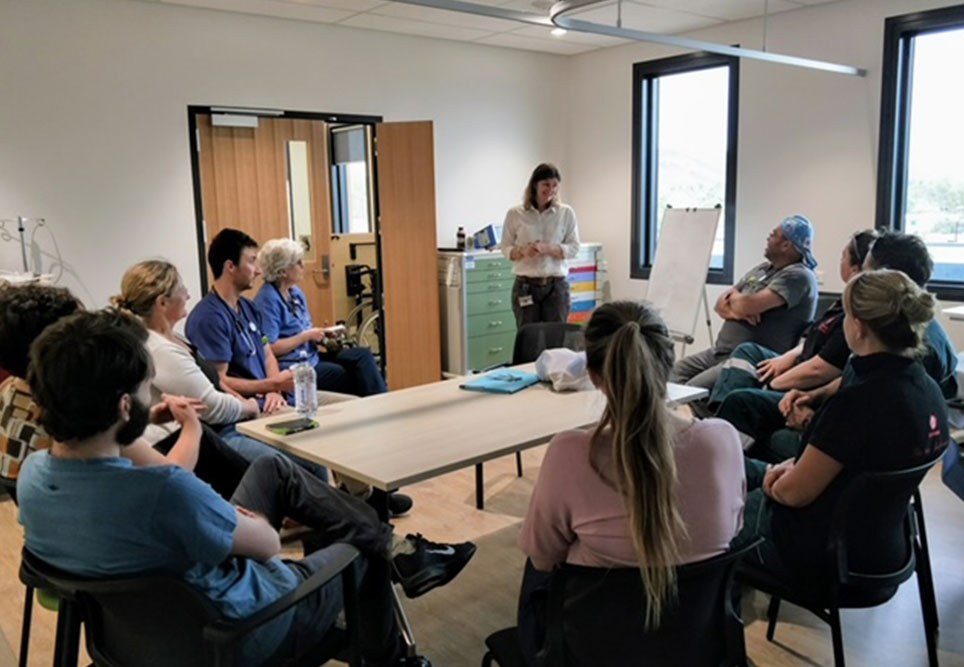This site may not work properly using older versions of Edge and Internet Explorer. You should upgrade your browser to the latest Chrome, Firefox, Edge, Safari, or any other modern browser of your choice. Click here for more information.
Your Stories
This is where we tell your stories, cover topical issues and promote meaningful initiatives.
Early intervention crucial for burn victims
First responders can dramatically improve outcomes for burn victims, reducing the need for a graft by fifty per cent. Here Dr Helen Douglas, who works for the State Burns Service in WA, talks about the importance of the initial management of a burn, which is often within the purview of the remote area nurse.
Early and effective intervention is crucial for burns victims, says Dr Douglas, a specialist surgeon in the field of burns.
“Proper treatment and speedy transfer times can make a huge difference … all before I get involved,” she says.
Dr Douglas, who works at the Fiona Stanley Hospital in Perth, Perth Children’s Hospital and The Scar Clinic Perth, is involved in the rural and remote Burns Management Program funded by WA Health and spearheaded by Sharon Rowe, Clinical Nurse Consultant on the unit, providing face-to-face mentoring and training in outlying towns.
Dr Douglas’s mentor is Fiona Wood, head of the State Adult Burns Unit at the Fiona Stanley Hospital, whose spray-on skin made her a household name after the Bali bombings.
The spray-on skin that Fiona has devised has been a game changer, says Helen.
“A postage-size piece of skin can be used for a whole palm-sized burn. It is like grass growing,” she says.
“This means we don’t see the kind of scarring that we used to see – a lot of it is thanks to this.”
One of Fiona’s early achievements was the development of a skin culture lab in the early 1990s, which she co-founded with scientist Marie Stoner. Their spray-on skin product is a world-first and has been used on thousands of patients throughout the world.
Dr Douglas, who trained in plastic surgery, had always planned to specialise in burns.
“It is so rewarding,” she says, “and certainly covers an amalgamation of working with medicine and with surgery, while offering a variety of work, dealing with every age group, every gender, every part of the body.”
Treatment
In terms of treating burns, Dr Douglas points out that, as RANs know, cool running water is best, with the cool treatment reducing the depth of the burn. Sooner is obviously better, but even introduced within the first hours of the injury, this treatment has its benefits.
“However, running water is not always available in a rural or remote setting,” Fiona says. If that’s the case, “use a bucket of cool water, [during transport] for example, and cool packs are terrific at controlling symptoms.
“The problem with the bucket of water is that the temperature of the water will gradually increase, but it’s much better than nothing.”
Definitely no ice, she says. “That will do more damage.”
With any first response, the primary survey is of course the same, Dr Douglas points out, with the need to follow the same process to ensure there are no life-threatening situations.
Of particular note within the primary survey are E for exposure (while you have to keep the burn cool, the patient has to be kept warm) and F is for fluids (ensuring enough fluid is in the body to keep the patient’s heart pumping).
It’s best to give fluids orally, and clear fluids are best, such as apple juice, but, unless they are heading for emergency surgery, milk can be used too.
“The important issue is to keep the gut moving, stopping it from going on strike,” says Dr Douglas.
“You don’t want a bacterial infection to start because the gut barrier has broken down.
“With all of this, it’s important to liaise with the Royal Flying Doctor Service [or other telehealth arrangement] for advice.”
Types of burns
Rural areas may experience a higher incidence of mine site accidents, involving industrial chemicals, such as very strong acids and alkalis, but in the home, paediatric burns are also common.
Young children are likely to get burns from touching something hot or pulling something hot onto themselves, says Dr Douglas, while burn accidents with older children and teenagers can be from a flame and friction, perhaps a motorbike accident.
Scalds are a common source of burns for children aged two to five, says Helen, as they are at the exploratory stage. And in terms of burns treatment, babies and toddlers are not mini-adults.
“Their heads are big compared to the rest of their body,” she says. “While in adults the head is nine per cent of the body, in newborns, it is eighteen per cent, dropping one per cent each year. They are also more prone to low blood sugar levels and they have thinner skin. The upside is that children do heal quickly.”
Rural and remote health workers need to have the right items in their kit: this includes silver dressings, which can stop bacteria from contaminating the raw wound.
Dr Douglas’ journey to Australia
Dr Douglas, who graduated in medicine in 2004, came to Australia from England in 2016 to complete her specialist plastic surgery training, and she’s been here ever since.
“It was a no-brainer for me. To have Fiona Wood as my mentor was amazing, and the job is incredible,” she says.
Fiona is a Fellow of the Royal Australasian College of Surgeons and the Royal College of Surgeons of England and was awarded the prestigious Ian McGregor Gold Medal for outstanding performance in her specialist examinations in 2015, before coming to Australia. She is also a member of the Australia and NZ Burns Association.
Dr Douglas is now married to a West Australian and has two children.
For further information on managing burns, read the CRANAplus Q&A on paediatric burns.

